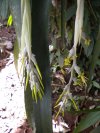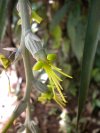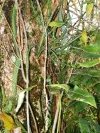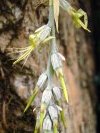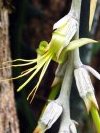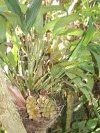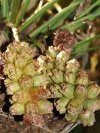 |
QUICK SEARCH
MO PROJECTS:
Africa
Asia/Pacific
Mesoamerica
North America
South America
General Taxonomy
Photo Essays
Training in Latin
America
MO RESEARCH:
Wm. L. Brown Center
Bryology
GIS
Graduate Studies
Research Experiences
for Undergraduates
Imaging Lab
Library
MBG Press
Publications
Climate Change
Catalog Fossil Plants
MO DATABASES:
W³MOST
Image Index
Rare Books
Angiosperm
Phylogeny
Res Botanica
All Databases
INFORMATION:
What's New?
People at MO
Visitor's Guide
Herbarium
Jobs & Fellowships
Symposium
Research Links
Site Map
Search
|
Draft Treatments | Guidelines | Checklist | Citing | Editors The Cutting EdgeVolume XVII, Number 1, January 2010News and Notes | Leaps and Bounds | Germane Literature | Season's Pick | Annotate your copy Billbergia macrolepis L. B. Sm (Bromeliaceae) and Chorigyne pterophylla R. Erikss. (Cyclanthaceae), though both monocots, are featured this month more because of their common flowering or fruiting time (now!) rather than any close kinship.
Following a hiatus of more than a century, the handsome B. macrolepis, first collected in Costa Rica by Henri Pittier on 1 January 1892, has resurfaced with a vengeance in recent years. Although it was reported in this rag [The Cutting Edge 10(3): 3–4, Jul. 2003] that Manual co-PI Barry Hammel had rediscovered it from near the original locality in 2003, he had unknowingly collected it three years earlier from nearby. Both of those collections were in fruit, and the plants found in 2008 and 2009 by Península de Osa botany king Reinaldo Aguilar in his dominion were likewise fruiting or sterile. Finally, just last December, Reinaldo's wife and collaborator Catherine Bainbridge sent us what may be the first photos of flowers of this sp. (first two images above). See more of Reinaldo's fine photos of this species, images 54–58. And as if to prove that it does indeed flower at this time of year, Hammel's live plant, brought back from his 2003 trip, finally blossomed during the first and second weeks of the current year (last three images above). Although one could hardly ask for a more elegant bloom, the flowers of this, the only Costa Rican member of the mostly Brazilian Billbergia (ca. 50 spp. total, Mexico–Argentina), would seem to be among the more subdued in the genus. Check out images on the Internet, e.g., especially of B. zebrina (Herb.) Lindl., to get our drift. We also decided to include photos of fruiting Chorigyne pterophylla, another sp. captive at the Hammel ranch, originally vouchered by Hammel 22397 (INB) and brought back from INBio's Finca Bosque Lluvioso, along the Río Claro near Guápiles
|
© 1995-2025 Missouri Botanical Garden, All Rights Reserved
4344 Shaw Blvd.
St. Louis, MO 63110
(314) 577-5100
Technical Support
